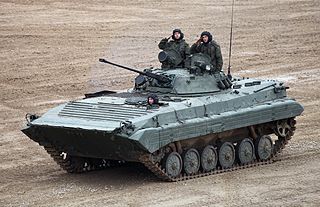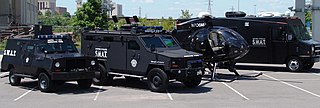Related Research Articles

The Defence Forces of Georgia, or Georgian Defence Forces (GDF), are the combined military forces of Georgia, tasked with the defence of the nation's independence, sovereignty, and territorial integrity. They consist of the Land Force, Air Force, National Guard, and Special Operations Forces. The Defence Forces are under overall leadership of the Minister of Defence of Georgia and directly headed by the Chief of Defence Forces.

The High Mobility Multipurpose Wheeled Vehicle is a family of light, four-wheel drive, military trucks and utility vehicles produced by AM General. It has largely supplanted the roles previously performed by the original jeep, and others such as the Vietnam War-era M151 Jeep, the M561 "Gama Goat", their M718A1 and M792 ambulance versions, the Commercial Utility Cargo Vehicle, and other light trucks. Primarily used by the United States military, it is also used by numerous other countries and organizations and even in civilian adaptations. The Humvee saw widespread use in the Gulf War of 1991, where it navigated the desert terrain; this usage helped to inspire civilian Hummer versions. The vehicle's original unarmored design was later seen to be inadequate, and was found to be particularly vulnerable to improvised explosive devices in the Iraq War. The U.S. hastily up-armored select models and replaced front-line units with the MRAP. The U.S. military sought to replace the vehicle in front-line service under the Joint Light Tactical Vehicle (JLTV) program. In 2015 the Oshkosh L-ATV was selected for production.

A technical, officially a non-standard tactical vehicle (NSTV) in United States military parlance, is a light improvised fighting vehicle, typically an open-backed civilian pickup truck or four-wheel drive vehicle modified to mount SALWs and heavy weaponry, such as a machine gun, automatic grenade launcher, anti-aircraft autocannon, rotary cannon, anti-tank weapon, anti-tank gun, ATGM, mortar, multiple rocket launcher, recoilless rifle, or other support weapon, etc.

The Russian Airborne Forces is the airborne forces branch of the Russian Armed Forces. It was formed in 1992 from units of the Soviet Airborne Forces that came under Russian control following the dissolution of the Soviet Union.

The BMP-1 is a Soviet amphibious tracked infantry fighting vehicle that has been in service from 1966 to the present. BMP stands for Boyevaya Mashina Pyekhoty 1, meaning "infantry fighting vehicle, 1st serial model". The BMP-1 was the first mass-produced infantry fighting vehicle (IFV) of the Soviet Union. It was called the M-1967, BMP and BMP-76PB by NATO before its correct designation was known.

The BMP-2 is an amphibious infantry fighting vehicle introduced in the 1980s in the Soviet Union, following on from the BMP-1 of the 1960s.

The M113 is a fully tracked armored personnel carrier (APC) that was developed and produced by the FMC Corporation. The M113 was sent to United States Army Europe in 1961 to replace the mechanized infantry's M59 APCs. The M113 was first used in combat in April 1962 after the United States provided the South Vietnamese army (ARVN) with heavy weaponry such as the M113, under the Military Assistance Command, Vietnam (MACV) program. Eventually, the M113 was the most widely used armored vehicle of the U.S. Army in the Vietnam War and was used to break through heavy thickets in the midst of the jungle to attack and overrun enemy positions. It was largely known as an "APC" or an "ACAV" by the allied forces.

The PT-76 is a Soviet amphibious light tank that was introduced in the early 1950s and soon became the standard reconnaissance tank of the Soviet Army and the other Warsaw Pact armed forces. It was widely exported to other friendly states, like India, Indonesia, Iraq, Syria, North Korea and North Vietnam.

A SWAT vehicle, police armored vehicle, or police rescue vehicle is a non-military armored vehicle used by police tactical units to respond to incidents. They are most often in configurations similar to military light utility vehicles, infantry mobility vehicles, or armoured personnel carriers. They are generally designed to have armor that can sufficiently block high-caliber rounds, space to carry the unit's equipment, and sufficient passenger seating; some also allow for additional personnel to hang onto the side of the vehicle in transit.

The BTR-70 is an eight-wheeled armored personnel carrier originally developed by the Soviet Union during the late 1960s under the manufacturing code GAZ-4905. On August 21, 1972, it was accepted into Soviet service and would later be widely exported. Large quantities were also produced under license in Romania as the TAB-77.

The M8 Armored Gun System (AGS), sometimes known as the Buford, is an American light tank that was intended to replace the M551 Sheridan and TOW missile-armed Humvees in the 82nd Airborne Division and 2nd Armored Cavalry Regiment of the U.S. Army respectively.

The Sherpa Light is a family of 4x4 tactical and light armored vehicles developed by French company Renault Trucks Defense (RTD). Available in unarmoured or armoured variants, the Scout is suited for tactical missions such as scouting, patrol, convoy escort and command and liaison. It is able to transport up to 4 or 5 soldiers or a total payload of up to 4 tonnes.

The Cadillac Gage Ranger, known popularly and in United States military service as the Cadillac Gage Peacekeeper or Cadillac Gage Peacekeeper I, is a four-wheeled armored personnel carrier marketed as an internal security vehicle, produced by Cadillac Gage. Built on a Dodge truck chassis, production began in 1979 to produce an armored vehicle for the United States Air Force (USAF) Security Forces, its largest customer, though Luxembourg and Indonesia also reportedly used Rangers as well. The Ranger also saw considerable service with law enforcement as a SWAT vehicle.

The Cobra is a family of armoured tactical vehicle developed by Turkish firm Otokar. It is produced in two generations. The first generation has some subsystems from the Humvee.

The International M1224 MaxxPro MRAP is an armored fighting vehicle designed by American company Navistar International's subsidiary Navistar Defense along with the Israeli Plasan Sasa, who designed and manufactures the vehicle's armor. The vehicle was designed to take part in the US military's Mine Resistant Ambush Protected vehicle program, led by the US Marine Corps, as well as a similar US Army-led Medium Mine Protected Vehicle program.

The Wolf Armoured Vehicle is an armoured personnel carrier, used mainly by the Israeli Defence Force. It was created to provide a better handling and better protected armoured vehicle than the M113 (Bardelas). The Wolf is a heavily armoured crew carrier, manufactured by the company Carmor. It combines a commercial truck's speed and maneuverability and APC-like armour, qualities necessary for low-intensity confrontation. The Wolf's chassis is based on a Ford F-550 truck, and is equipped with a 6-litre V8 engine capable of reaching 325 horsepower. The engine is combined with a 5-speed automatic transmission, which drives all four wheels, making this a four-by-four.
DELGA may refer to:
The Soviet BMP-1 is a tracked, amphibious infantry fighting vehicle (IFV) with a long service history.

The Didgori-I is an armoured multi-role and special operations vehicle produced by STC Delta. It was developed in 2009, alongside the Didgori-2 using the same internal features with some additional functions. The armoured personnel carrier is thought to provide transport, enhanced visibility and firepower support for infantry troops and Special Forces in various missions including reconnaissance and convoy protection.
References
- ↑ "Delga-1 vehicle". xn. Retrieved 14 August 2023.
- ↑ "БОЕВОЙ АВТОМОБИЛЬ "ДЕЛГА-1" НА БАЗЕ "НИВЫ" (ГРУЗИЯ)". www.sinopa.ee. Retrieved 14 August 2023.